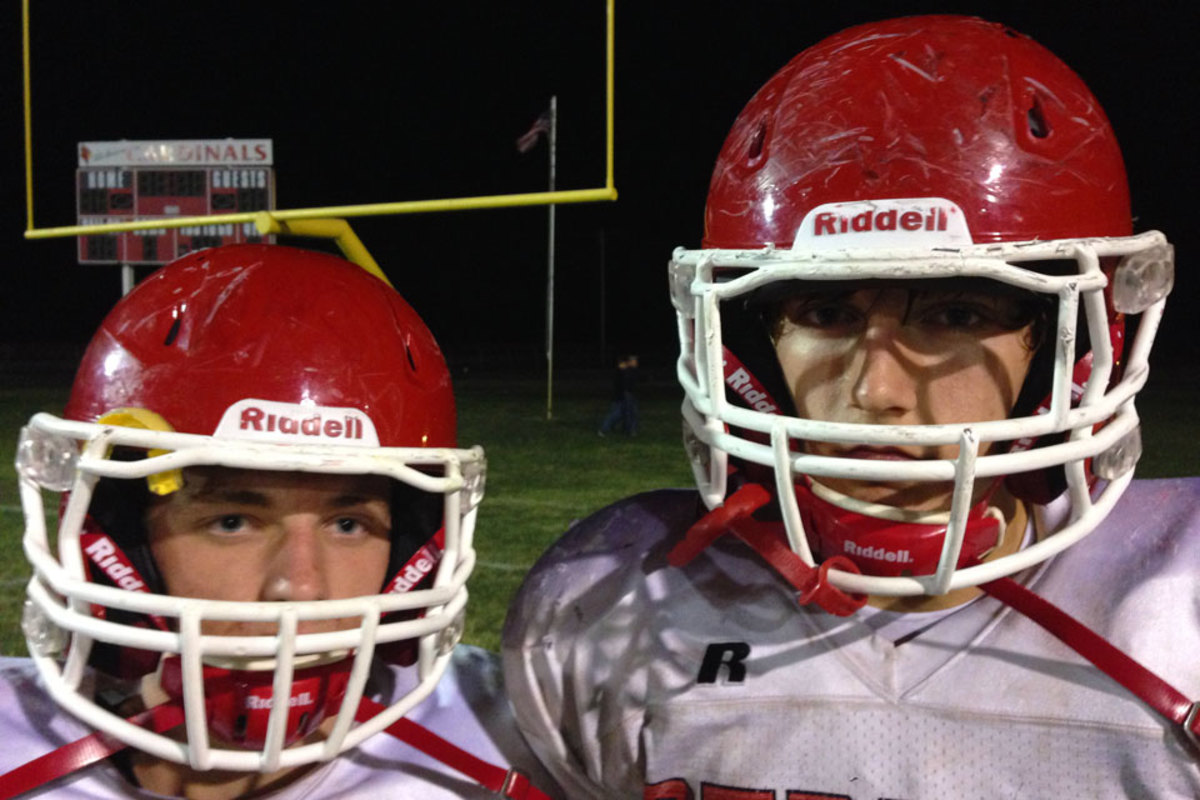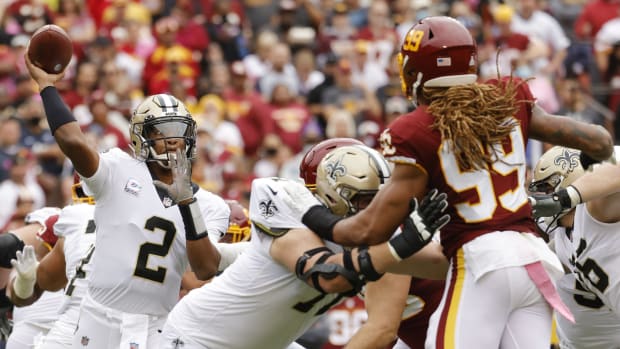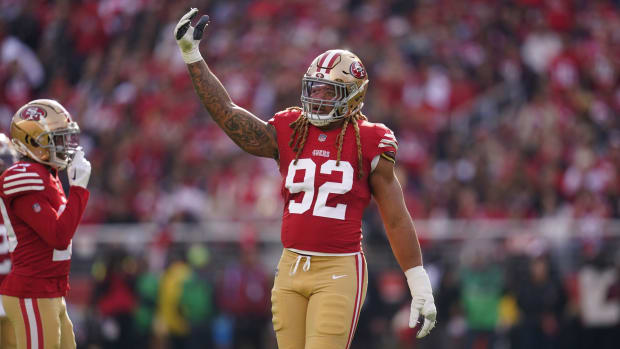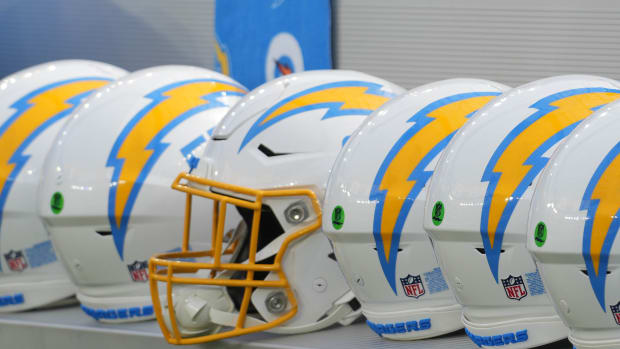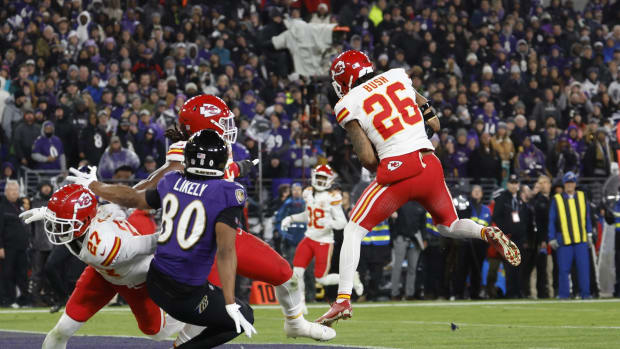A Way of Life
SMITH CENTER, Kan. — The head football coach was bailed out this time. There was, thankfully, an athletic trainer on hand to look into the teenager’s eyes, to have the player recall what he did earlier in the day, to ignore his cries of “I’m fine!” He wasn’t fine: The next night he would leave the homecoming dance early, complaining about loud music and bright lights.
It was the trainer’s decision to pull the player from the game, after diagnosing him with a concussion. But had the trainer, who travels 160 miles round-trip to attend this high school’s home games, not been able to make it—or had the team been on the road—it would have been on the coach to recognize a problem and make the proper medical call.
“Most kids can’t hide concussions,” says the first-year varsity coach, who has been around football for 20 years and takes an hour-long rules and health course every preseason. “They’re bawling, crying. They’re confused. But this one probably could’ve gotten away with it.”
Let’s back up.
Can football change? Will the sport become safer? How are concussions impacting the game’s future?
Introducing an in-depth series where we tackle those questions, starting at high schools and continuing into college and the NFL. Read the entire series.
As The MMQB set out to learn about head injuries in football—about the protocols and the varying attitudes across the country toward concussions—what better place to go, we thought, than the actual center of the U.S.? You might be surprised to learn there’s an official geographical center of the contiguous U.S., landmark and all. It’s just outside of a small Kansas town called Lebanon (pronounced “Leb-nun” by locals). There’s no high school there anymore. It closed in the 1980s as the population declined. The children of farmers and store owners and teachers graduated from high school, left town and never came back.
So the town sent its boys and girls 15 miles west to Smith Center High, which had the country’s longest active winning streak in football until 2009. It ended that year at 79 games. The legendary coach presiding over the streak sent several players on to the NFL, most notably Mark Simoneau, an All-America linebacker at Kansas State who played for the Eagles, Falcons, Saints and Chiefs in a 10-year career. New York Times writer Joe Drape traveled to Smith Center in 2007 to write a book about the team, the town and the coach, Roger Barta, who retired after last season. (The book, Our Boys, is quite good). The new head coach is Darren Sasse, 40, a former junior high coach and varsity assistant who grew up in this town of 1,600.
Ten days ago I travelled with the Smith Center team to its game against Ell-Saline High in Brookville, Kans., a town of fewer than 300 people that’s measured not in square miles but in square acres (366). I wanted to get an in-depth look at how concussions are being treated—diagnostically and philosophically—in America’s heartland.
Wyatt Oliver, a senior linebacker/center, suffered a concussion the week before Smith Center's game against Ell-Saline. Asked by a certified athletic trainer which classes he attended earlier in the day, Oliver quipped, "All of ’em." By Kansas rule he was required to sit out a week. (Robert Klemko/SI)
The linebacker/center described at the beginning of this story, senior Wyatt Oliver, made the trip even though he hadn’t been cleared to play after being diagnosed with a concussion. Oliver stands 6-0 and is an athletic 180 pounds. He can snap the ball reliably and can run down ball-carriers with ease. On a team of 36 players culled from a student body of 121, he does both. In a game the week before I arrived in Kansas, he was in pursuit of Washington County’s quarterback when at the last moment the QB ducked, and the crown of Oliver’s helmet collided with a teammate’s chest. He staggered to his feet a few seconds later. The trainer asked him what classes he’d been to that day. “All of ’em,” Oliver said, trying to pull a fast one.
He was done for the night, and wouldn’t be allowed to play again until he passed the ImPACT test, which was developed by the University of Pittsburgh Medical Center in 1999 and has become widely used in recent years as the dangers of concussions have become better understood. For the first time, the boys at Smith Center are being tested this year by New West Sports Medicine in Kearney, Neb., with funding coming from a grant by Good Samaritan Hospital in Kearney and the Smith Center school district. (The grant covers 45 Nebraska schools and 10 Kansas schools.) Though the accuracy of the ImPACT test has come under recent scrutiny, it requires healthy athletes to take a baseline test that can be compared to a concussed player’s cognitive ability later in the season.
I met with Wyatt’s mom, Traci, in Brookville, about 115 miles southeast of Smith Center. Because there are so few schools in this part of the country, Smith Center will log more than 600 miles traveling round trip to its four scheduled away games this season. Traci drove the two hours to watch the game even though her two sons didn’t play—by Kansas rule Wyatt was mandated to be out for one week following a concussion diagnosis (the ImPACT test still to come), and his younger brother, Dalton, a freshman, was still recovering from a broken bone at the bottom of his pelvis.
This is how a lot of kids get into junior colleges to go to school," said Wyatt's mom, Traci Oliver. "My heart stopped when he laid on the ground last week, but he got up.
Smith Center didn’t need either of the Oliver brothers in their 43-8 victory over Ell-Saline. The visitors took an early lead on a 1-yard touchdown plunge by senior running back Grant Lambert two minutes into the game, and the successful two-point conversion was a nearly identical smashmouth play.
“At Smith Center,” one mom explained, “we hit hard, we don’t pass, and we don’t kick.”
For as long as anyone can remember, the team has run a wishbone offense with a fullback directly behind the quarterback and two tailbacks split behind the fullback. Sasse added a new wrinkle this year: the short shotgun snap, also known as the pistol. Sasse wanted the quarterback to have a better view of the defense when making decisions with the ball on option plays. There’s also been a reluctant acknowledgement of a new football trend sweeping the nation—the forward pass. Coach Barta’s offensive goal had always been 400 yards rushing per game. Sasse now wants 300 yards rushing, and 100 passing. He’s on his way: Smith Center had 60 through the air against Ell-Saline.
Smith Center senior quarterback Kody Molzahn (12) intentionally hid a concussion his sophomore year. "I just love the game of football, and I don't want to stop playing," he said. "I don't know any long-term effects, so I've got nothing to be scared about." (Jack Crier/Smith County Pioneer)
Mrs. Oliver and I sat together in the bleachers during the first half, taking in the sights and talking football. Behind us, a two-lane road leading to Interstate 70 cut through vast fields of grain and other crops that seemed to touch the horizon in all directions. In front of us, dressed in red jackets and thigh-high green skirts, all five Smith Center cheerleaders danced to late ’90s jock jams blasting from a boombox. In the stands across the field, girls from Ell-Saline were already attired for the postgame homecoming dance. Wearing puffy, strapless dresses in hues of purple, blue and red, they wandered between the gym and the bleachers for much of the night.
At one point in the second quarter, a Smith Center defender was the second man in on a tackle, his face mask colliding with the back of the running back’s head. Yellow flags came flying out, and Smith Center was penalized 15 yards for “targeting the head.” About 75 Smith Center fans, who were separated from the field by a six-lane black rubber track, became incensed. A white-haired man wearing a red jacket and jeans jumped to his feet. “Come on,” he yelled. “Let ’em play football!” Another man spit a cloudy brown mixture into a half-filled plastic bottle before shouting, “That’s bogus!”
I asked Mrs. Oliver if head injuries frighten her, if she’s ever considered not letting her sons play for fear of brain trauma. Wyatt has had just that one concussion. His younger brother was knocked unconscious in a wrestling match last year. She paused briefly at the question.
“No. Not when you’re from Smith Center,” she said. “That’s what it is here. Now, if he had a second one, we would worry. But it’s a way of life out here. This is how a lot of kids get into junior colleges to go to school. Of course my heart stopped when he laid on the ground last week, but he got up.”
Wyatt tried to hide his concussion, but the athletic trainer couldn’t be fooled. Smith Center’s senior quarterback, Kody Molzahn, had to move on with the backup center, and the pair did fine against Ell-Saline, acing every shotgun snap. Watching from the back row of the bleachers, Molzahn’s father told me he remembered just one time when Kody had a concussion. There was another instance, the dad said, when Kody “had his bell rung, but I didn’t consider it a concussion.”
“I’ve kept up on the stuff that happens to pro athletes. And it’s scary,” said Dan Molzahn, a farmer. “But honestly, with my sons I never worried about it. If the doctor says they can go, they go. We try to leave it up to our sons—are you ready to play, or are you not ready to play? Because I expect 100% when you’re out there.”
No Smith Center player was concussed on this night—or rather, none reported a concussion. It’s a good thing, because no trainer was there to evaluate players.
Kody has an older brother who played for Barta and once suffered a concussion so severe that he missed two weeks of practice a few years ago. But that kind of precaution wasn’t always the norm here. When Smith Center was good—five-state-championships-in-a-row good—there was more pressure on players to get back on the field and less knowledge about concussions, Sasse told me. In 2007, the starting quarterback of Smith Center’s eventual state championship team suffered a concussion in practice, and there was some discussion whether he should play that very week. “He didn’t play,” says Sasse, a varsity assistant at the time. “I don’t know what we would’ve done if it had been the playoffs. You’d like to think we would’ve done the right thing for the kid, but who knows?”
Sasse has been reading up on head injuries, and his football program is, at least by area standards, progressive. Smith Center players wear the most advanced Riddell helmet—the 360, a next-generation design featuring flexible face mask attachments, which cost between $310 and $390 apiece. Many programs in the area offer these helmets to varsity athletes if their families split the cost with the school. Smith Center’s are paid for entirely by the district, which receives a helping hand from alumni benefactor R.D. Hubbard, a manufacturing mogul and racetrack and casino owner who was responsible for funding the team’s home stadium and the football building down the street from the school.
As a result of what he’s learned about brain trauma, Sasse has tried to minimize contact in practice: The team had long performed the “Buffalo drill,” a hitting exercise that produces a dozen face-to-face, helmet-to-helmet collisions between two players in a 30-second span. When Sasse took over in May 2013, and concussion testing was put in place, the coaches debated whether the drill should continue. “One of the coaches said, ‘We’ve got to be physical,’ and I could just see the junior high coach shaking his head,” Sasse says. “We want to be violent, and we want to teach kids to be the hammer not the nail, but we had to change it.”
They tweaked the drill: Players now hit one another shoulder to shoulder instead of face to face.
Safety Taylor Zabel (28) threw his body around like a missile in Smith Center's 43-8 victory over Ell-Saline. He said of one bone-crushing hit, "I'm just looking to make the play. I'm not trying to kill the guy. I feel fine." (Jack Krier/Smith County Pioneer)
In Brookville, the boys did plenty of hammering. Smith Center incurred two more penalties for targeting the head. Each time, a defender joined in on a tackle and connected with the ball-carrier’s head. Parents bemoaned both calls, but it was another hit—a legal one—that drew the biggest reaction of the night. Late in the fourth quarter, with Ell-Saline muddled in its own red zone, Smith Center safety Taylor Zabel sniffed out a receiver slant and pounced hard on Ell-Saline wideout LuizAntonio Arceo. A redwood of a teenager who stands 6-5 and weighs 195 pounds, Zabel plunged his right shoulder into Arceo’s chin a split-second after the ball arrived, knocking the smaller boy three yards backward. Zabel walked away stiffly, fists clenched, as teammates exalted him and Arceo labored to his feet.
After the game, a booster slapped Zabel on the back on his way out of the visiting locker room and said, “Number 16 is going to remember your name.” I had asked Zabel about that hit before he went into the locker room. His shaggy, matted blond hair towered over me, and there were red marks all over the shoulders of his white jersey. He held his cherry red helmet under an arm, showing off as many pride stickers (27) as scuff marks from opponents’ face masks. But there’s more to Zabel than his simply being an athlete. He says he scored a 32 on his ACTs and wants to go to Harvard or Yale, but not necessarily for football.
During Smith Center's postgame prayer, one player said, "Thank God that we came out with the victory and no one on our side was seriously injured." (Robert Klemko/SI)
“I’m just looking to make the play,” he said of breaking up that pass. “I’m not trying to kill the guy. I feel fine.”
I also met with Kody Molzahn, the quarterback, and asked him if he’s ever hidden a concussion from coaches and family. I could tell he wanted to say no, but he couldn’t lie. “Yes, I have hidden it, sir, to be honest,” he said. “I just love the game of football, and I don’t want to stop playing. It happened sophomore year. You just keep playing. I don’t know any long-term effects, so I’ve got nothing to be scared about.”
No Smith Center player was concussed on this night—or rather, none reported a concussion. It’s a good thing, because no trainer was there to evaluate players. The certified athletic trainer from Kearney, Neb., John Uelmen, can only attend Smith Center’s home games because he is responsible for 11 other schools and logs roughly 600 miles a week on the road. This bothers assistant coach Mike Rogers, a Smith Center graduate and former All-America running back at Kansas.
“For about five years we’ve had a certified athletic trainer at most home games,” Rogers told me as we waited outside the locker room after the game. “That’s probably the best way; to have a guy come in from the outside and make a decision. But for small schools like ours, you just don’t know if it’s financially feasible to have a trainer at every game.”
After changing into jeans and shoes—basketball high-tops for most, dusty cowboy boots for others—the boys climbed aboard the charter bus for the long ride back to Smith Center. We stopped at a McDonald’s along the way, the parents having chipped in enough money for each player to get a $12 meal allowance. Oliver sat at a table across from his coaches, worried that wouldn’t be cleared on Monday morning when the trainer came back to town to check on the team.
“What if I’m just dumb and I fail the test?” he asked Sasse, only half-joking.
“Well, if you’re dumb,” Sasse said, “you were dumb two months ago when you took the baseline, so it’s gonna come out OK.”
Wearing T-shirts that boasted, "Welcome to the New Age," Smith Center players had to wait 90 minutes for McDonald's to make enough food for their 10:30 p.m. to-go order. (Robert Klemko/SI)
Even though coaches had called ahead, McDonald’s wasn’t ready to be overtaken by a football team at 10:30 p.m. It took an hour and a half to produce enough double cheeseburgers and fries for four dozen players and coaches, who ate the to-go orders on the bus. We pulled into the parking lot at the Smith Center football complex shortly after 2 a.m. Minutes later the players piled into newish pickup trucks, SUVs and 1980s-era Cutlasses and took off for home, some of them driving at least another hour to get to their family’s farms.
Sasse, the last man to leave, was back at the complex five and a half hours later to throw the uniforms in the wash—only to find out that another coach had already done it. He then went to the school to copy the game film from the camera card to the computer editing software. He thumbed through a red folder and glanced at the game plan for Ell-Saline. He looked baffled. Why didn’t the opponent target his backup center with their stud defensive tackle? He wondered aloud when he might get his starting center back. In time for the playoffs, surely. But this week?
The ImPACT test is no sure thing, Sasse told me. A sophomore passed it earlier in the season but was still experiencing concussion symptoms, including headaches and sensitivity to light. He ended up sitting for two additional weeks—the trainer’s call. I asked Sasse what will happen the next time a teenager gets lit up on the field and does his best to pretend his brain is just fine, but there isn’t a trainer to make a diagnosis?
“My coaches have experience,” he said. “They can diagnose knees and can usually tell if a player isn’t acting right. But they’re gonna ultimately turn to me and say its your decision. And that’s fine. That’s one of those things that comes with being a head coach.”
































